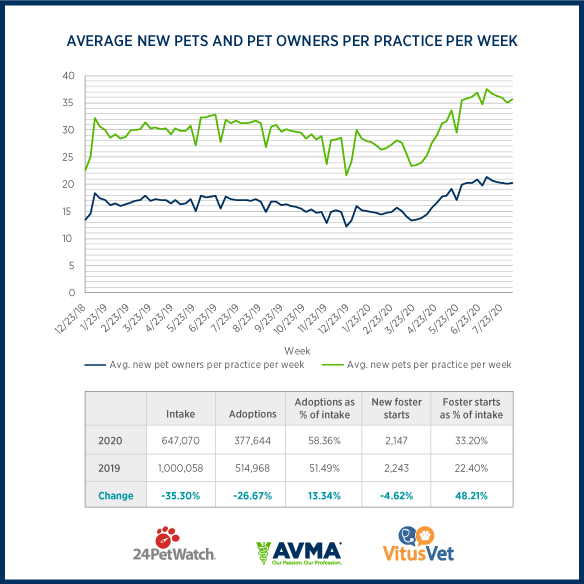Are pet adoptions really skyrocketing?
News reports on the popularity of pet adoptions have been something of a staple during the COVID-19 pandemic. The heartwarming anecdotes and surge of media reports got AVMA’s economists thinking and wondering: Is there data to confirm the trend?
Today’s chart sheds some light on the popularity and prevalence of adoptions during the pandemic. As it turns out, adoption rates have indeed increased in the nation’s pet shelters, but the trend isn’t as substantial as reports might lead us to believe.
What the data show
Veterinary practices are busy places right now, and one big reason is that veterinarians are seeing more new patients and new clients. As the line graph here demonstrates, there has been an uptick in pet ownership during the COVID-19 pandemic.
Practices are seeing new pets and new pet owners
The graph, based on data from VitusVet, shows the average number of new pets and pet owners seen by veterinary practices on a weekly basis. While these numbers dipped early in the pandemic, the number of pets being seen by veterinary practices has increased significantly since late March. In fact, the average number of new pets per practice rose from 23 per week in March to 36 in August – an increase of more than 50%.
What's happening in animal shelters?
Are new pet adoptions responsible for all of this increased activity? It’s hard to know for sure. But data from 24PetWatch and Best Friends Animal Society give us a window into what’s going on in animal shelters.
In the table, we see that the rate of pet adoptions – adoptions as a percentage of animals taken into shelters – has in fact risen this year: 58.36%, compared with 51.49% in 2019. But the number of pets brought into shelters (intakes) has fallen significantly during the pandemic. So the actual number of pets being adopted is lower than during the same time frame last year.
What does it mean?
Veterinary practices are busy, and many of the patients we’re seeing are newly adopted pets. Assuming these adoptions are successful, and pets remain in their new homes after the pandemic, this could have longer-term implications for veterinary businesses – and pet health. Veterinarians who develop and solidify relationships with these animals and their owners can hope to keep providing high-quality care for these new patients for years to come.
Some ways to build these relationships:
- Employ a regular communication program that connects the practice with clients on an ongoing basis, through email, text, social media, and other digital platforms. Use these communications to show that you care about clients' animals and are available to answer questions on everything from nutrition and behavior to pain and illness.
- Find opportunities to talk about preventive care with clients. Help them understand everything the veterinarian looks for during a wellness exam.
- Forward book each pet’s next preventive exam, in addition to any needed re-checks. Forward booking is a convenient service for clients and helps ensure that more animals get needed wellness care. It also allows your practice to have more control over scheduling, which can be especially helpful during busy times.
- Be upfront with clients in talking about price, cost of care, treatment options, and payment options. With unemployment high, paying for care could be a concern for many pet owners.
- Proactively communicating about financial options can help clients make the decision to seek veterinary care, as can being thoughtful in developing care plans for patients whose owners may be struggling financially.
Practical resources to build relationships
These AVMA resources – free of charge to all AVMA members – can help you build and solidify strong relationships with new and existing clients:
- Tools for communicating with clients during COVID-19
- Tips for socializing dogs during the pandemic
- Money tips for caring pet owners
The AVMA also is a lead partner in the Partners for Healthy Pets initiative, which provides additional tools to help veterinary practices support preventive care. For example:
- Forward booking toolkit
- Communications tools to support preventive care
- Monthly payment plans for preventive care
Special thanks to VitusVet, 24PetWatch, and Best Friends Animal Society for providing data and insights to the AVMA.




Comments
increase number new pets/clients
As I understand it the data, as presented, does not indicate that the increase in new patients are necessarily new pets for the owners. Is it possible that we may be seeing patients that were owned prior to the pandemic but were seeking care elsewhere ( shot clinics, spay/neuter clinics, other) and may not be able to get that care now?? Maybe some new clients have had prior care at another clinic that (due to the pandemic) is unable to meet their needs? We have had new clients come in that expressed dissatisfaction with their prior clinic because they only allowed curbside service, could not see the pet in a timely manner or had appointments cancelled due to staffing shortages/Covid concerns. Some clients came in because they now had extra funds (due to the $600/wk boost in unemployment). Just this morning we saw two established clients with an ill senior pet each that had been getting no, or minimal, preventative care elsewhere but a new pet to us.
Also, you should not use the lowest point in March to compare the uptick to. Maybe compare it to the highest point prior to that (June 2019) or, at least, to the avg in the year or two prior to March.
Add New Comment